Alaska Fish & Wildlife News
February 2025
Stalking Shorebirds on Alaska’s Remote Outer Coast
Researching Elusive Red Knots Part 2

The backstory and pilot season were featured in January. Jenell Larsen Tempel picks up the story as the project gains momentum, and bears…
In 2022 we launched our first season in Controller Bay surveying for Pacific Red Knots - small, resilient, gorgeous, plump little birds in a location that for them was essentially a gas station on their way to their real destination, the Arctic. Our new survey methods involved a mark-resight approach to estimate abundance. Mark-resight or mark-recapture methods are common in wildlife studies. They rely on counting the number of marked individuals and non-marked individuals in a set area and timeframe, which provides an estimate of the population there at that time. Markings can be natural like pelage patterns on giraffes, spots on leopards, and patterns on the flukes of a humpback whale; or they can be manufactured by wildlife biologists and include collars, ear tags, flipper tags, or brands.
In our case we were relying on leg flags. The flags are worn somewhat like anklets 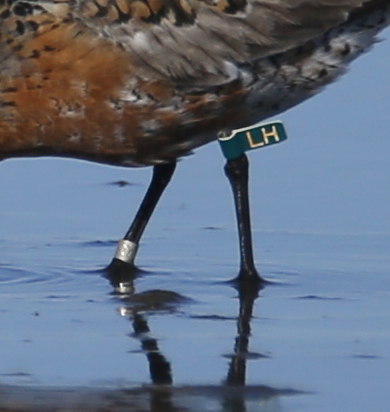 around the bird’s leg. In fact, that joint you see on birds that looks like the knee but bends backwards is the bird’s ankle joint! The flags are about the length of your fingernail and are made of durable plastic. Each one is engraved with an alphanumeric code unique to the individual bird. The flag color identifies the country where the bird was captured and tagged. For example, the US is green, Canada is white, and Mexico is “purple red” or maroon as I would call it. However, not all banders adhere to their assigned color schemes. The Red Knots that we see in Controller Bay that were captured and tagged in Northwestern Mexico all have yellow bands, like the one below, whereas we did have one bird tagged
around the bird’s leg. In fact, that joint you see on birds that looks like the knee but bends backwards is the bird’s ankle joint! The flags are about the length of your fingernail and are made of durable plastic. Each one is engraved with an alphanumeric code unique to the individual bird. The flag color identifies the country where the bird was captured and tagged. For example, the US is green, Canada is white, and Mexico is “purple red” or maroon as I would call it. However, not all banders adhere to their assigned color schemes. The Red Knots that we see in Controller Bay that were captured and tagged in Northwestern Mexico all have yellow bands, like the one below, whereas we did have one bird tagged 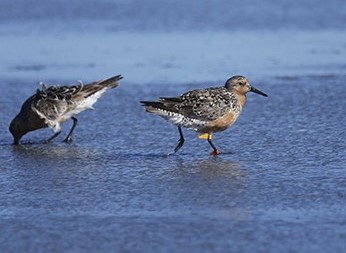
The camp location I selected for my crew in 2022 was in the middle of the bay. The nearest landmark was the Edwardes River and so we called the camp “Edwardes,” but in reality it was a bit more than three miles from the 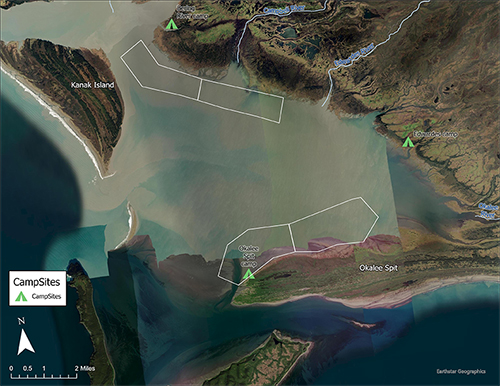 river. Edwardes River is in upper right, Edwardes camp is the green tent icon in middle right. Oakalee spit and 2022 camp is near the bottom edge. We situated our big cook tent in the tall grass, well above the high tide rack line. It was too large to set up in the shelter of the trees, which were really just a bunch of young, dense alders.
river. Edwardes River is in upper right, Edwardes camp is the green tent icon in middle right. Oakalee spit and 2022 camp is near the bottom edge. We situated our big cook tent in the tall grass, well above the high tide rack line. It was too large to set up in the shelter of the trees, which were really just a bunch of young, dense alders.
There were four of us at camp during the inaugural year of the project: Lyda, my tough no-nonsense, right-hand woman that also lived in Juneau. She made supply lists, packed and shipped gear, and helped me shop for everything we could possibly need for a month. She was skilled in wilderness first aid, had a lot of flight experience in helicopters and fixed wing airplanes, and the person I would want by my side when things go south any day. Aaron and Evan made up the other half of our crew. Aaron I met via word of mouth when I was putting this project together. Aaron lives in Cordova and is a professional birding guide, a culinary creative, and one of the most humble, easy going people I have ever had the pleasure to work with. Then there was Evan. Unlike Lyda and Aaron who I hired on as seasonal field crew, Evan came to volunteer. He had been a Ducks Unlimited intern for the Forest Service the year before and loved it so much he wanted to come back and was just looking for something to do. I didn’t know what kind of person would volunteer to spend three weeks in the wilderness doing what we were about to do, but I figured they had enough experience to know what they were getting into. As it turned out Evan was from Texas, did not cook and could not distinguish a vegetable from a fruit, but was crazy about waterfowl, a great birder and had a great attitude. The four of us formed a small unit for about one month together in the wilderness.
We arrived in pairs. Aaron and I were there first and selected the camp spot for both the cook tent and the 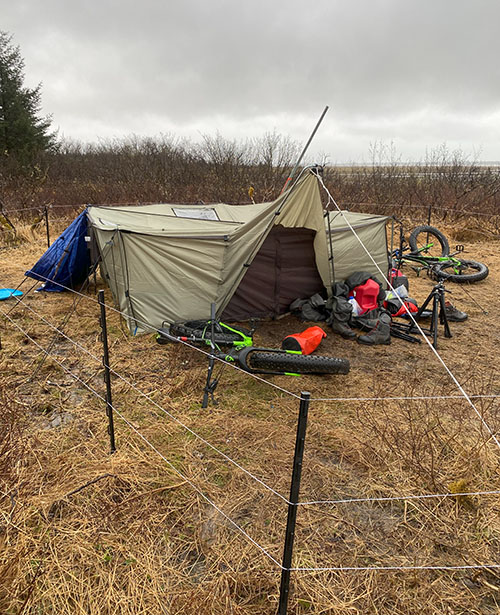 sleeping tents. This was harder than it sounds. The four sleeping tents needed to be together - because of bears, we needed to set up an electric fence around the tents. The spot needed some protection from the wind and needed to be on high enough ground to be out of standing water. After some wandering, Aaron found this amazing wooded area amongst the alders on slightly higher ground that looked big enough. We went with it and once Lyda and Evan arrived, we began to set up. It was only then that I realized a handsaw or hatchet would have been ideal. Given no other option, Evan immediately got to work cutting the alders with the dull blade of a shovel. We worked all afternoon and were still not done by nightfall. We ended up eating dinner after 11 pm and sleeping all together in the 10 x 10 ft cook tent (it took us two days to get the camp set up in the alder thicket). The next morning, we spent half the day conducting our first surveys, bracketing the two hours surrounding the high tide and then came back to do more camp chores and make a plan for the following day because we knew the weather was about to change for the worse.
sleeping tents. This was harder than it sounds. The four sleeping tents needed to be together - because of bears, we needed to set up an electric fence around the tents. The spot needed some protection from the wind and needed to be on high enough ground to be out of standing water. After some wandering, Aaron found this amazing wooded area amongst the alders on slightly higher ground that looked big enough. We went with it and once Lyda and Evan arrived, we began to set up. It was only then that I realized a handsaw or hatchet would have been ideal. Given no other option, Evan immediately got to work cutting the alders with the dull blade of a shovel. We worked all afternoon and were still not done by nightfall. We ended up eating dinner after 11 pm and sleeping all together in the 10 x 10 ft cook tent (it took us two days to get the camp set up in the alder thicket). The next morning, we spent half the day conducting our first surveys, bracketing the two hours surrounding the high tide and then came back to do more camp chores and make a plan for the following day because we knew the weather was about to change for the worse.
A big day
On our third day an impeding storm was forecasted, and the winds were starting to pick up. We decided that two of 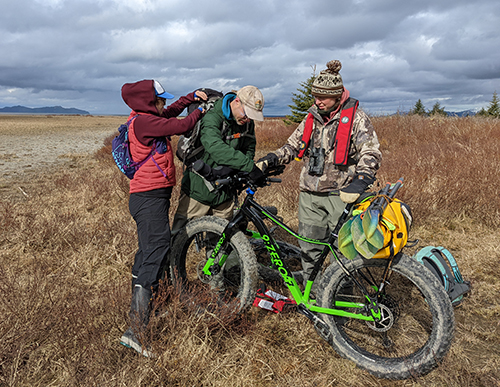 us would do a survey and the other two would finish setting up camp and batten down the hatches for the gale force winds and rain coming our way. Aaron and I made the survey team and we decided to see how far we could go north. Our goal was to make it all the way to the Campbell River which was the full distance of the survey polygon. It was time to see if the survey design was feasible. We packed for a big day. The packraft was potentially going to be needed for river crossings. How we would get the bikes across was not fully discussed, but we would figure it out on the fly or stash them up in the alders. Lyda and Evan helped us get everything strapped on to our bikes and bodies. I didn’t even have enough funds in the budget to buy waterproof backpacks that year, so we made some by running bungie cords through the handles of drybags and wearing what formed shoulder loops.
us would do a survey and the other two would finish setting up camp and batten down the hatches for the gale force winds and rain coming our way. Aaron and I made the survey team and we decided to see how far we could go north. Our goal was to make it all the way to the Campbell River which was the full distance of the survey polygon. It was time to see if the survey design was feasible. We packed for a big day. The packraft was potentially going to be needed for river crossings. How we would get the bikes across was not fully discussed, but we would figure it out on the fly or stash them up in the alders. Lyda and Evan helped us get everything strapped on to our bikes and bodies. I didn’t even have enough funds in the budget to buy waterproof backpacks that year, so we made some by running bungie cords through the handles of drybags and wearing what formed shoulder loops.
We biked in silence much of the way. It was too much effort to converse in the wind. We forded “No Name Creek” fairly easily once we found the shallowest section. We got off the bikes and pushed them through the water by the handlebars, careful to keep the optics dry. The fat tires rose to the surface and threatened to flip the bike in the current so a stabilizing hand on the seat was necessary to keep it upright. We observed flocks of Dunlin, Black-bellied Plovers and Short and Long-billed Dowitchers feeding in the intertidal. We stopped periodically to scan each flock for knots. At one point we saw a large flock of more sizeable birds.
We ditched the bikes up by the wrack line and made our way closer to the water’s edge, optics in hand. “Oh wow,” 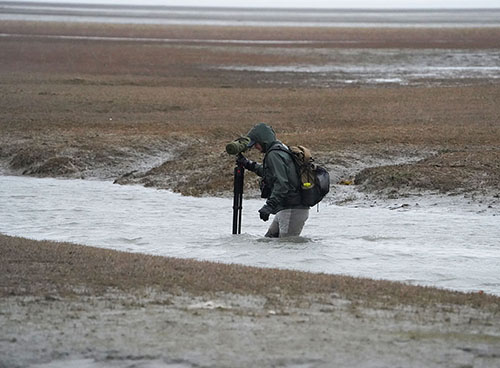 Aaron said after a quick glance through his binoculars. “Knots?” I asked as I raised mine up. No, they were not knots. They were too large- godwits. I scanned the flock looking for smaller knot-sized birds. Nothing. Disappointed, I was ready to move on and keep biking but Aaron’s voice stopped me. “This is incredible.” He said walking at a quicker pace toward the flock. I wondered if I would find it incredible. He stopped 60 feet from them, and we set up the spotting scopes. He was quiet. I could tell he was counting. Good practice, I thought and counted them too. “There are 480 Marbled Godwits, right here in this flock!” He said breathlessly. “I’m shaking,” he said looking down at his quivering hand. “No one is going to believe me when I post this on ebird.” I had just one objective for this project and it was to estimate the abundance of Red Knots. I didn’t understand what could be so exciting about a couple hundred
Aaron said after a quick glance through his binoculars. “Knots?” I asked as I raised mine up. No, they were not knots. They were too large- godwits. I scanned the flock looking for smaller knot-sized birds. Nothing. Disappointed, I was ready to move on and keep biking but Aaron’s voice stopped me. “This is incredible.” He said walking at a quicker pace toward the flock. I wondered if I would find it incredible. He stopped 60 feet from them, and we set up the spotting scopes. He was quiet. I could tell he was counting. Good practice, I thought and counted them too. “There are 480 Marbled Godwits, right here in this flock!” He said breathlessly. “I’m shaking,” he said looking down at his quivering hand. “No one is going to believe me when I post this on ebird.” I had just one objective for this project and it was to estimate the abundance of Red Knots. I didn’t understand what could be so exciting about a couple hundred 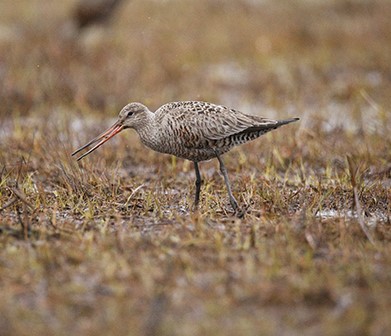 godwits. Sure, they were beautiful birds but what was he all shook up about? He explained that these birds belonged to the Beringian population of Marbled Godwits, of which there were an estimated 2,000 in the entire population. This is very small for any shorebird population. And we saw one quarter of the entire population right here all together on this speck of the bay in one day. We went on to see all three godwit species that day - Marbled, Hudsonian and Bar-tailed in a single flock.
godwits. Sure, they were beautiful birds but what was he all shook up about? He explained that these birds belonged to the Beringian population of Marbled Godwits, of which there were an estimated 2,000 in the entire population. This is very small for any shorebird population. And we saw one quarter of the entire population right here all together on this speck of the bay in one day. We went on to see all three godwit species that day - Marbled, Hudsonian and Bar-tailed in a single flock.
We did make it all the way to the Campbell. But the going was tougher on the way back. The 30 mph winds were hitting us in the face and it was difficult to keep peddling at an adequate speed. Although I enjoyed watching the godwits and was happy to learn that we could cross the rivers and streams and make it to the Cambell River, I was feeling rather downtrodden.
“Aaron, I need a break,” I said as we crested a small knob of sand and found ourselves on hard ground dotted with vegetation no more than half an inch high. I felt as flat as the blades of grass I was sitting on. Aaron was on cloud nine. He had never seen so many godwits and couldn’t wait to tell his friends about it. He was barely even winded. But he could tell I was struggling, “Are you doing ok?” He asked innocently. “I’m not so sure this is going to work out. I mean what kind of crazy project did I get us into? We will have put in over 20 miles today and we haven’t seen a single knot. It’s so muddy, do they even like this habitat? Where’s all the sand like on the Okalee Spit side? And tomorrow we have to do it all over again. And the next day. What if we don’t see any? What if we spend the next three weeks biking and hiking our tails off and we don’t even see them.” I was convinced this was the stupidest and hardest project I ever could have taken on. It was going to fail. It became blatantly obvious why no one had ever surveyed this bay on foot for any species.
I now look back on that day with fondness. Aaron and I heated up some soup via a pocket rocket stove and talked birds. I learned he was so good at biking because he used to do bike touring trips and lived all over in different countries. He was so genuinely happy to be doing this, in this special place he had always wanted to visit. His attitude was contagious, and I decided then and there that even if we failed, I had surrounded myself with the best 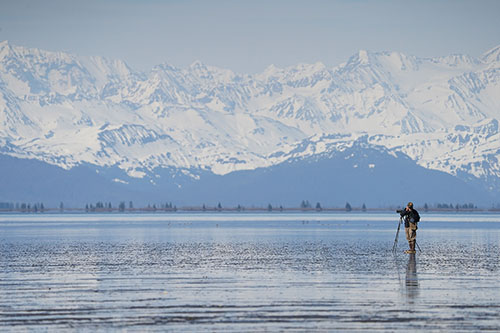 possible people and we were going to have a good time doing it. If we didn’t see enough knots to get an abundance estimate so be it. In the meantime we were going to learn every possible thing there was to know about conducting surveys in Controller Bay and how we could make improvements for the 2023 season.
possible people and we were going to have a good time doing it. If we didn’t see enough knots to get an abundance estimate so be it. In the meantime we were going to learn every possible thing there was to know about conducting surveys in Controller Bay and how we could make improvements for the 2023 season.
The foreseen and the unforeseen
As any biologist will tell you when launching a new field project, the first season is full of kinks and issues and for this reason I launched 2022 as a pilot season. It was a spring dedicated to figuring it all out. Where were the knots? When did they arrive and when did they depart? How much of the bay could we reasonably survey? Could we even do it on foot? Did we need to cover all of it? I knew up front some of the hurdles would be a challenge - the logistical difficulty of setting up field 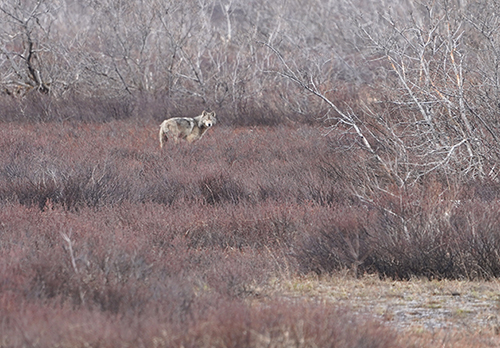 camps in a remote location; I knew the weather would be cold, wet and windy most of the time and we would need an adequate way to dry out during our three week stay; I knew the bay contained every large apex land predator in Alaska (brown bears, black bears, wolves, coyotes) and these could be problematic around camp. And then there were all of the unforeseen issues that you might not anticipate. For example:
camps in a remote location; I knew the weather would be cold, wet and windy most of the time and we would need an adequate way to dry out during our three week stay; I knew the bay contained every large apex land predator in Alaska (brown bears, black bears, wolves, coyotes) and these could be problematic around camp. And then there were all of the unforeseen issues that you might not anticipate. For example:
- Weather that included one weeklong storm of 45-80 mph winds that knocked down our cook tent and ripped the top open. We remedied this by patching the hole with a spare rubber rain jacket.
- We did not have enough people to cover the bay. It would have taken an army of 20 people to do this well.
- Some of the camps had poor optics which meant they could not read the flags well, especially in jarring, windy conditions.
- The birds were not accessible in some locations, due to deep channels of water and far offshore sandy islands that they sometimes preferred to roost and forage on.
- The biking was tough going. For folks that were regular or avid bike riders it was good on sandy
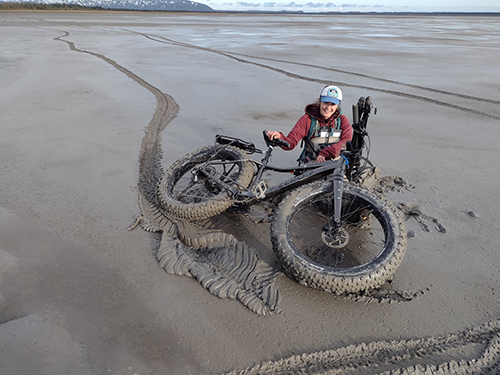 stretches of shoreline. However, most people could walk as fast as they could ride - and exert less energy. Also, the areas of mud in the bay were very slick and resulted in wipe outs which covered gear in muddy silt.
stretches of shoreline. However, most people could walk as fast as they could ride - and exert less energy. Also, the areas of mud in the bay were very slick and resulted in wipe outs which covered gear in muddy silt. - We did not time the migration well. We arrived on April 28 and departed on May 19, right as the Red Knots were peaking in numbers.
- Lack of rest.
- Field injuries. Blisters were common and few wading boots are comfortable when walking 8-20 miles per day. I ended up just wearing crocs instead for most of the season. Other injuries included a sliced open finger from cleaning a bike rotor, sore knees, weird rashes from sweating in waders all day, and foot problems. Our camp medic, Lyda, tended to everyone that would let her. Daily, she checked
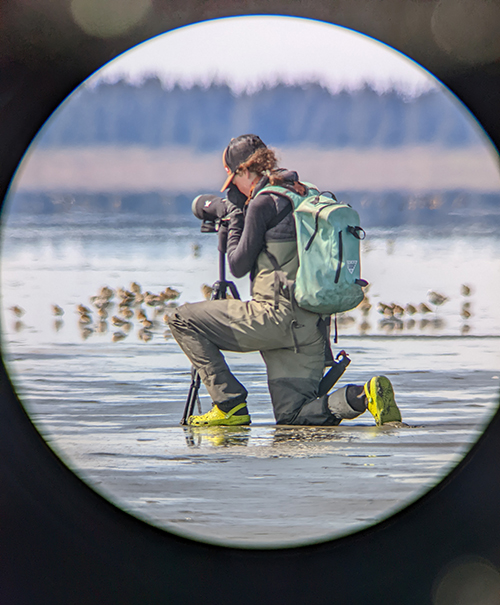 wounds, wrapped up feet and doled out moleskin.
wounds, wrapped up feet and doled out moleskin. - Communication or “comms” as we like to call it was a challenge. Each camp had a VHF radio and a satellite phone and each pair of individuals had an Inreach device. We had hoped we could communicate camp-to-camp using VHF radios. The distances between camps were treeless, wide-open expanses so we had clear lines of sight. In fact, when surveying we could sometimes see the miraging image of another observer on foot or bike miles away. However, the radios lacked the power to reach the other camps. If we wanted to talk to each other (which was important from a safety standpoint as well as to discuss changing flight schedules), we needed to text Inreach-to-Inreach, wait for a response and set up a time to use the satellite phone. Then there was the joy of finding a good clear view of the sky while it was pouring rain and gusting wind. You would maybe get 30 seconds of conversation between dropped calls.
- Steve’s plane got stuck in the mud on an incoming tide at one of the camps.
- High tides and storms. These events left you with wet waders to put on every day, infiltrated freshwater streams with saltwater which was not very tasty, and increased the depth of streams which made stream crossings with the bikes a bit dicey.
- Poor camp placement. I thought I had selected the perfect camp spot. We were right next to a
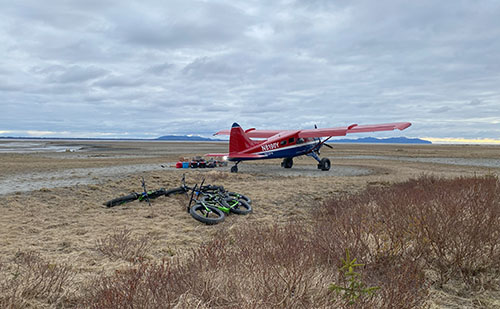 freshwater creek, protected by alders, close to the woods for firewood for the wood stove, and we had a decent runway for Captain Steve to land during weekly resupply runs. Unfortunately, the tide ran so far up the creek that it made the water brackish. After two dehydrating days we determined it was undrinkable even when we added in flavored electrolyte packets to our water bottles. The other nearest creek was 1.5 miles from camp each way. Every day a pair of folks made the three-mile trek to bring home a few liters of water that we needed for drinking and cooking.
freshwater creek, protected by alders, close to the woods for firewood for the wood stove, and we had a decent runway for Captain Steve to land during weekly resupply runs. Unfortunately, the tide ran so far up the creek that it made the water brackish. After two dehydrating days we determined it was undrinkable even when we added in flavored electrolyte packets to our water bottles. The other nearest creek was 1.5 miles from camp each way. Every day a pair of folks made the three-mile trek to bring home a few liters of water that we needed for drinking and cooking.
Bears and more bears
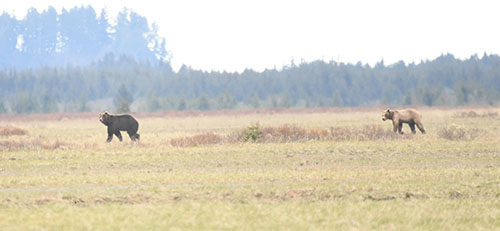 Last but not least: Bears. What was even worse than the three-mile water trek was the fact that we found ourselves in a bear thoroughfare. The first week out there it stormed hard every day. It was so wet and miserable that we didn’t see a single mammal in that week-long stretch. After the seventh and final day of the storm (when it gusted 80 mph overnight and tore down the tent) it got still and cold. Ice in your water bottle cold. The full moon rose, and I could feel the bay coming alive after it s long slumber.
Last but not least: Bears. What was even worse than the three-mile water trek was the fact that we found ourselves in a bear thoroughfare. The first week out there it stormed hard every day. It was so wet and miserable that we didn’t see a single mammal in that week-long stretch. After the seventh and final day of the storm (when it gusted 80 mph overnight and tore down the tent) it got still and cold. Ice in your water bottle cold. The full moon rose, and I could feel the bay coming alive after it s long slumber. 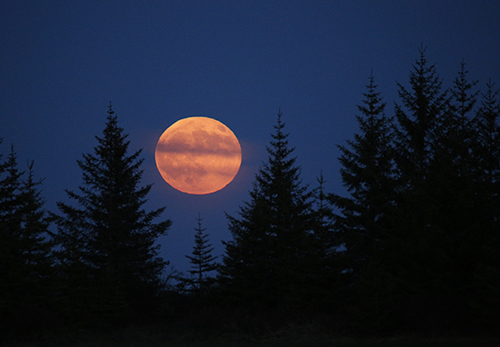 The next day Evan and I went to gather firewood and just as we came around a wooded area and got a view of the creek, we saw a sow brown bear with two, 2-year-old cubs. “Bear,” I said in a hushed voice. She was probably 350 yards, too far to hear us. Evan turned on his heel in panic to run. I reached my arm through his in a do-si-do fashion. “It’s ok, they haven’t seen us, let’s just let them know we’re here. Stand tall and look big.” We yelled and they ran off. It was a very positive experience. Little did we know we would be seeing her and her young every day for the rest of the season.
The next day Evan and I went to gather firewood and just as we came around a wooded area and got a view of the creek, we saw a sow brown bear with two, 2-year-old cubs. “Bear,” I said in a hushed voice. She was probably 350 yards, too far to hear us. Evan turned on his heel in panic to run. I reached my arm through his in a do-si-do fashion. “It’s ok, they haven’t seen us, let’s just let them know we’re here. Stand tall and look big.” We yelled and they ran off. It was a very positive experience. Little did we know we would be seeing her and her young every day for the rest of the season.
The little salty creek provided freshwater further up and fresh green shoots for bears to graze on after their long hungry winter. This was her domain. We respected each other and got to know the behavior of her two nearly grown cubs. One was shy and timid, the other bold and curious. The female, however, was the least of our worries. It was mating season and every boar within 50 miles seemed to know she was there. Admiralty, Baranof and Chichigof (the “ABC Islands” of Southeast Alaska) are best known as having the greatest brown bear densities in North America. I challenge that fact. In the last 10 days of the field season, we had 23 bear encounters all within a three-mile radius. I estimate that 11-13 of them were unique individual bears. I’m not sure why the sow didn’t move on. Perhaps she had been living, breeding and raising cubs in this small area her whole life. Perhaps she used us as a buffer to ward off the many males that came to pursue her.
During one encounter a large boar was in persistent pursuit. We watched from the comfortable distance of 450 yards as they had a standoff on the mud. She sat on her rump, her two cubs on either side of her. All with their 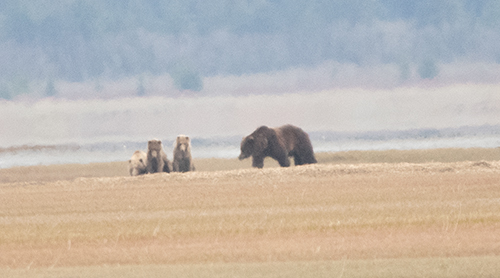 heads down, eyes focused on the ground as the boar walked right in front of them. They did not want to challenge him. He walked what appeared to be maybe 30 yards from her and then just laid down in the mud facing her, waiting. She laid down. They laid face to face. A downpour ensued and we sat in our camp chairs in the rain with the 12 gauge and the flares. All waiting. Finally, the curious cub broke the tension and walked forward, approaching the boar. Its intention appeared more curious than aggressive. We held our breath; this was potentially a challenge to the male and could be a death sentence. The female had no choice but to sit and defend her other cub. The bold one walked right up to the male and sniffed him. The boar didn’t move. He laid still and looked a bit bored, really. The youngster ran back to mom. After the shower passed, she had enough of the game and charged the boar, but stopped short of making contact. It was a warning, but she was not ready to fight. The family of three ran off into the woods.
heads down, eyes focused on the ground as the boar walked right in front of them. They did not want to challenge him. He walked what appeared to be maybe 30 yards from her and then just laid down in the mud facing her, waiting. She laid down. They laid face to face. A downpour ensued and we sat in our camp chairs in the rain with the 12 gauge and the flares. All waiting. Finally, the curious cub broke the tension and walked forward, approaching the boar. Its intention appeared more curious than aggressive. We held our breath; this was potentially a challenge to the male and could be a death sentence. The female had no choice but to sit and defend her other cub. The bold one walked right up to the male and sniffed him. The boar didn’t move. He laid still and looked a bit bored, really. The youngster ran back to mom. After the shower passed, she had enough of the game and charged the boar, but stopped short of making contact. It was a warning, but she was not ready to fight. The family of three ran off into the woods.
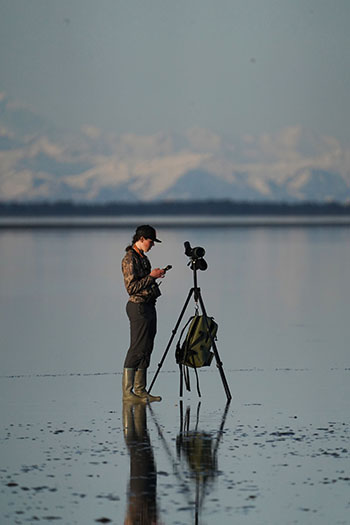 “Bear TV” as we called it became a daily occurrence every day at low tide. It wasn’t just the boars looking to breed we discovered, but every hungry bear about was cruising the coast to go clamming or discover a washed-up marine mammal carcass. We watched juveniles practice brawling in the saltwater, and solo bears lumber by in search of better foraging opportunities. Although it was amazing to be able to spend so much time watching brown bears interact with one another, mainly I found these experiences stressful and inconvenient. We constantly had to be on guard when going to the bathroom, gathering water, washing dishes and laundry, and bathing. It was our job to make sure the bears never associated us with food or got curious enough to come close to camp. We spent a lot of time being loud and I intentionally shocked myself about four times per day testing the bear fence.
“Bear TV” as we called it became a daily occurrence every day at low tide. It wasn’t just the boars looking to breed we discovered, but every hungry bear about was cruising the coast to go clamming or discover a washed-up marine mammal carcass. We watched juveniles practice brawling in the saltwater, and solo bears lumber by in search of better foraging opportunities. Although it was amazing to be able to spend so much time watching brown bears interact with one another, mainly I found these experiences stressful and inconvenient. We constantly had to be on guard when going to the bathroom, gathering water, washing dishes and laundry, and bathing. It was our job to make sure the bears never associated us with food or got curious enough to come close to camp. We spent a lot of time being loud and I intentionally shocked myself about four times per day testing the bear fence.
What was so irritating about it though was that though this section of the bay proved to be poor Red Knot habitat during our high tide surveys, it contained more foraging knots during low tide, and was the perfect time and place to collect fecal samples (below) for our diet study. However, this was also the same time when the bears were present.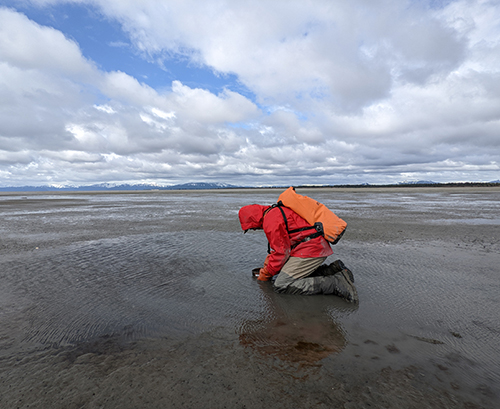
Next Month: Part 3
All photos copyright ADF&G, by Jenell Larsen Tempel, Blake Richard, Evan Ward and Lyda Rees.
The Institutional Animal Care and Use Committee (IACUC) reviews programs and projects to ensure animal welfare. IACUC protocol numbers for work done for 2021: 0107-2021-34; for 2022: 0107-2022-25.
More on the Threatened, Endangered and Diversity Program at ADF&G
Subscribe to be notified about new issues
Receive a monthly notice about new issues and articles.
